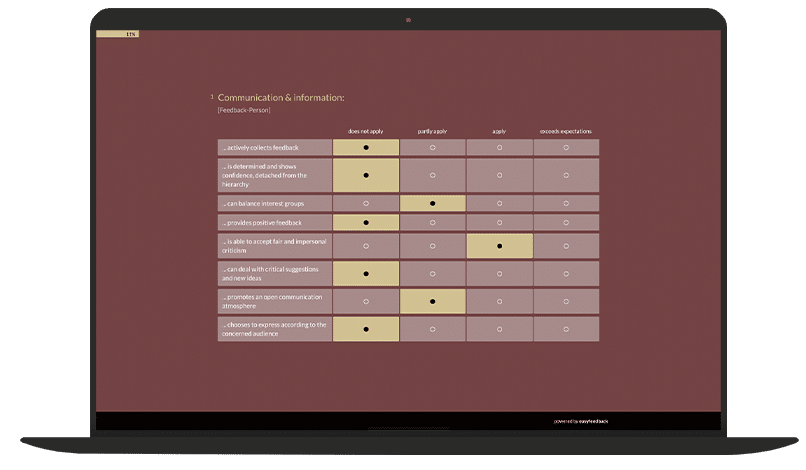Tip 1: Open communication (Preparation)
Even before the email invitation or cover letter for the survey, it makes sense that there is open communication between the manager and the team.
That is, if the situation in the team is tense or if the manager has the feeling that there is whispering behind the back, then this can of course have a negative impact on the assessments within the 360-degree feedback.
If this is the case, it makes sense for the manager to seek communication with the team in advance and clearly communicate the goals that are to be achieved with the help of the feedback.
It is important to make it clear that the feedback is intended to help the manager develop personally and professionally.
That the manager is aware of having weaknesses, that these are to be uncovered and proactively addressed with the help of the feedback, and that he/she is dependent on the help of colleagues in doing so.
If this is clearly defined and disclosed up front, the sentiment that employees bring to the appraisal will be much more constructive and benevolent.

Tip 2: Questionnaire design (Introduce constructive criticism)
As the author of the questionnaire, you are in control of how the survey plays out and can guide your participants toward constructive feedback.
For example, start with positive questions to set a positive mood among employees as they complete the questionnaire.
If I assume that my team is not in a positive mood towards me and the first block of questions I ask is only about the manager’s personal skills. Then it can happen that I already lead the employees into the survey in a negative way and that the basic mood runs through the entire survey.
A better way to start, for example, is with questions about the global mindset or the goals of the company, since it can be assumed that there will be a certain degree of agreement here.
This way, the survey starts neutrally and you achieve a neutral-constructive mood among the participants, which then carries over to the other questions.
Tip 3: The type of question (Do not use negations)
Sounds strange at first, but the way we ask the questions is the way we react to them.
If you ask the questions or the evaluation levels (good – bad) for the feedback of the leadership qualities in a negative form (e.g. What do you find bad about the leadership style of your superior?), then you already steer the employee in a negative direction.

It is better to formulate the questions and assessment levels in a neutral way (applies – does not apply).
Always try to put yourself in the manager’s or employee’s perspective and ask the questions and assessment levels from this perspective.
Conclusion
So, those were our three effective tips on how you can steer the 360-degree feedback to a constructive feedback and thereby avoid executives being pilloried.
At easyfeedback, we offer a template for 360-degree feedback. Using matrix questions, the executive receives feedback in 10 topic areas. Feel free to check out the template for more inspiration.

We wish you good luck with your next survey.
More on 360 Degree Feedback
- Everything you need to know about 360 degree feedback: process, info and tips
- How to: Conduct 360-degree feedback with easyfeedback
- 270-degree feedback: A valuable perspective for personal development
- Survey Template: 360 Degree Feedback
- Survey Template: 90 Degree Feedback
- Survey Template: 270 Degree Feedback




